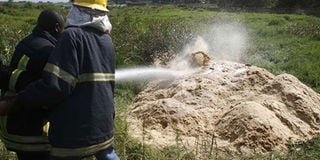Govt agencies tussle over healthy ways to dispose illegal goods

Contraband sugar is destroyed in Nakuru County. PHOTO | FILE | NATION MEDIA GROUP
What you need to know:
- Anti-Counterfeit Agency (ACA) assistant director Kipkemoi said they lack facilities and mechanisms for destroying hazardous counterfeit goods.
- The agency faces rampant corruption, negligence, poor coordination among State agencies manning the country's borders and other systemic weaknesses.
In May last year, something strange happened. About 400,000 kilos (400 tonnes) of illicit sugar was poured into the salty Indian Ocean in Mombasa as a way of getting rid of the contraband that had been declared unfit for human consumption.
But there was some contention about the method chosen to get rid of the product.
While other government agencies were in agreement that the sugar had to be destroyed, Anti-counterfeit Agency (ACA) and the National Environment Management Authority (Nema) were locked in a tussle.
The illegal sugar that was smuggled to the Mombasa port from Dubai.
ADVICE
The 16 containers of sugar had been declared as machine parts when they were intercepted in February 2016.
From the Anti-Counterfeit Agency's perspective, Nema failed to give them “reasonable” methods that they could use to destroy the contraband.
“When the first two options were off the table, we were left with one more way to destroy the sugar. Pour it into the ocean and sweeten the waters.
"But that was not so much an environmentally friendly option from Nema’s perspective but our only way out,” ACA’s assistant director of enforcement Lindsay Kipkemoi said.
Nema is mandated to guide the Anti-Counterfeit Agency on environmentally friendly destruction methods.
“In most cases, they just tell us how not to destroy the contraband. For instance, they told us to destroy the sugar by burning it, something that was not possible because sugar is not combustible.
"The second option was to take it to cement factories. But they turned us away because the by-product of sugar is water,” Mr Kipkemoi said.
POLLUTION
The final decision to destroy the contraband was dumping it into the ocean, a move that was made possible through an Executive Order as Nema had moved to block that destruction method.
Nema has refuted claims that it blocked the destruction, saying that it only provided the ACA with viable options which the latter misconstrued as intransigence.
“Our work is to give elaborate guidance on appropriate destruction method that will not pose any environmental pollution. But whenever we do this, sometimes it is taken as being tedious,” Nema deputy director of enforcement Salome Machua said.
Ms Machua said that the agency had advised that the sugar be dumped into a part of the ocean that was neither close to the shoreline nor a sensitive area which could affect marine life.
Nema’s role, according to Ms Machua, is to offer advice on environmentally friendly waste destruction methods and the appropriate firm to use to destroy waste products.
“The ACA or KRA writes to us outlining the type and nature of products they want to destroy. We then advise them on the licensed waste handlers they can use and how to go about destroying the products they have confiscated,” she said.
ROADBLOCK
Mr Kipkemoi said that the tug-of-war between the two agencies is one among many examples of the challenges the agency faces in destroying some illicit goods it confiscates during surveillance.
Speaking recently at a multiagency workshop on combating counterfeit drugs, Mr Kipkemoi said the country lacks proper destruction facilities for hazardous goods.
Over the last eight years, the Anti-Counterfeit Authority has seized counterfeit goods worth Sh1.5 billion but was only able to destroy goods worth Sh588 million.
As a result, there are stockpiles of undestroyed goods that are congesting the only two depots it owns.
As the war on, and influx of, counterfeits intensifies, so are the roadblocks that the ACA faces.
These include rampant corruption, negligence, poor coordination among State agencies manning the country's borders and other systemic weaknesses.
RESOURCES
Between 2010 and 2018, the agency received 1,279 complaints, investigated 1,054 but only prosecuted 221.
But with increase in seizures, why isn’t the destruction in line with what has been confiscated?
Currently, it is unable to destroy contraband worth Sh800 million in its depots. Some of these goods are too hazardous to destroy by burning.
These include fluorescent tubes and others that have mercury.
As long as there are no procedures, mechanisms and facilities to handle goods that cannot just be burnt, Mr Kipkemoi noted, the depots may soon be overwhelmed.
“Our depots are full with goods that we are unable to destroy as we lack extraction and destruction facilities that can safely handle these hazardous products. The only facility we had in Athi River is run down,” he added.
MULTIAGENCY
Ms Machua, however, refuted claims that the country does not have capacity to destroy hazardous goods.
“The only thing we lack capacity to destroy are nuclear waste; the rest we can handle,” she added, saying that there are more than five licensed private waste management facilities.
Last year, a multiagency task force was formed to combat the proliferation of counterfeit goods.
It comprises the Anti-Counterfeit Authority, Kenya Revenue Authority (KRA), Kenya Bureau of Standards (Kebs), Pharmacy and Poisons Board and National Police Service.
While Kebs is in charge of checking for quality, the KRA is tasked with collecting taxes.
The initiative has resulted in seizures of illegal goods valued at Sh13.5 billion through a seven-month rapid results initiative between May and November 2018.





